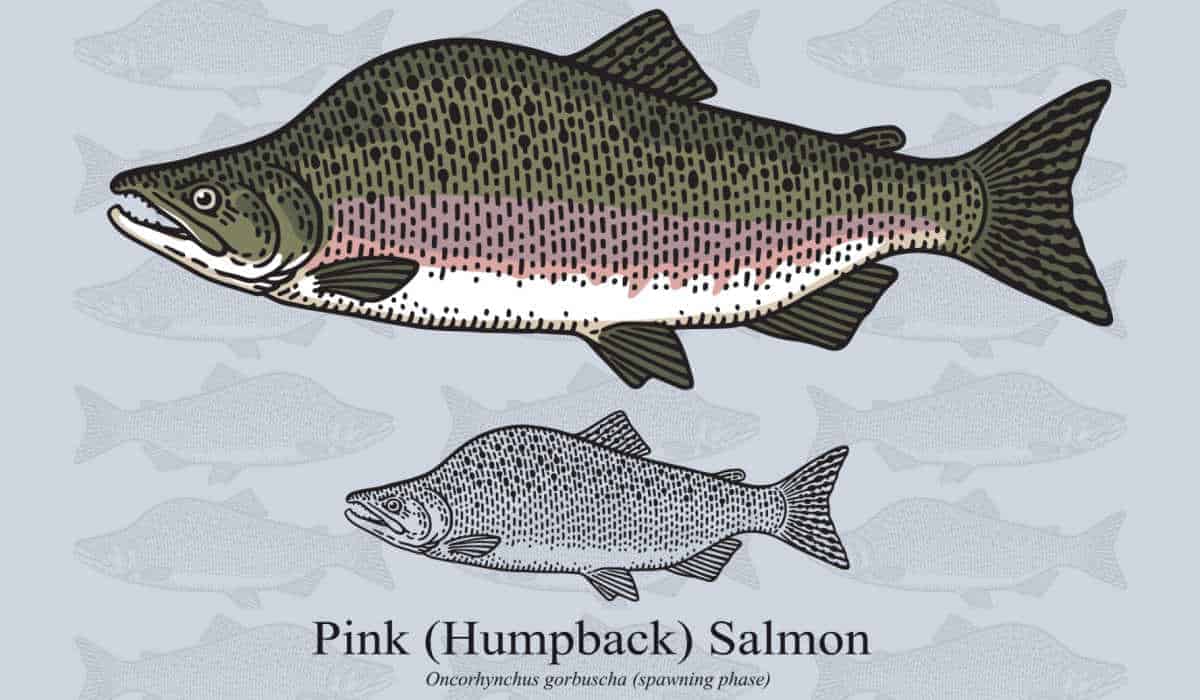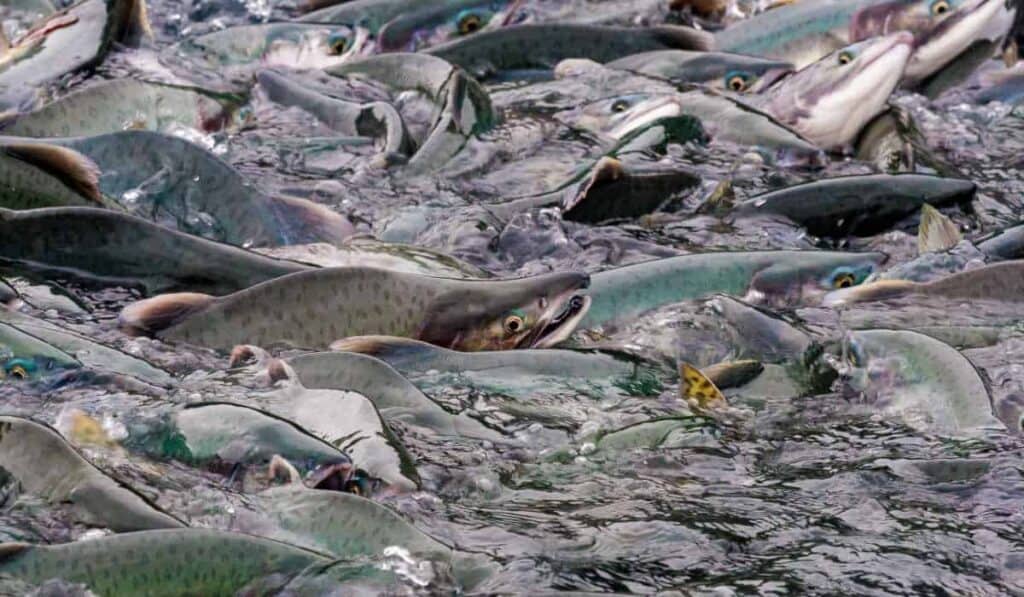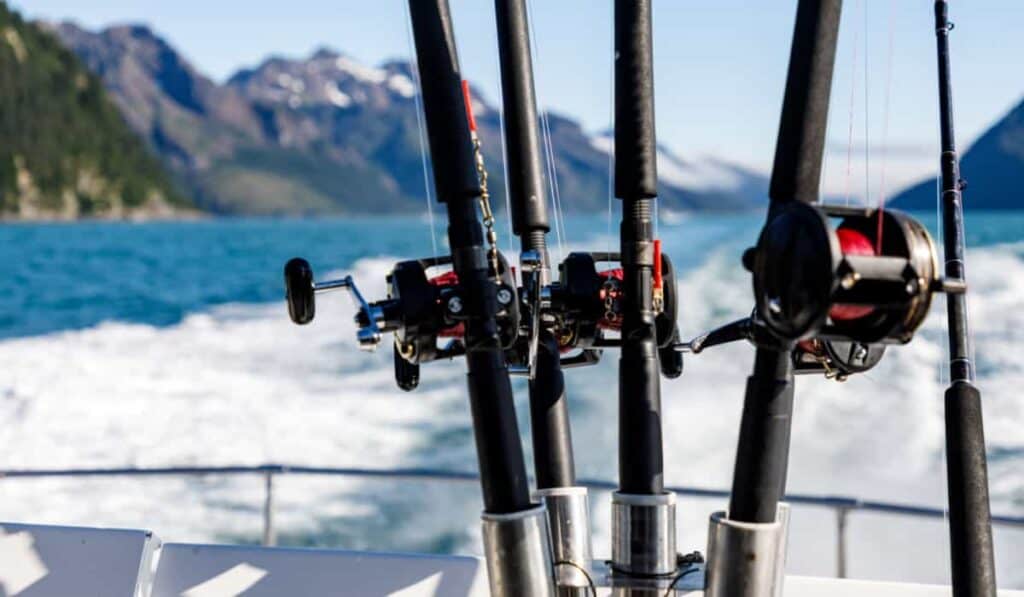When the summer season graces the majestic landscapes of Alaska, it brings not just the midnight sun but also an experience that every angler dreams of – the return of the salmon to their freshwater spawning grounds. Amid the five different salmon species found in Alaska’s icy waters, there’s one that holds a special place in the hearts of fishermen (and diners…) – the Humpy Salmon, otherwise known as Pink Salmon.
Pink Salmon, or Oncorhynchus gorbuscha, are colloquially known as Humpies in Alaska due to the distinctive hump males develop on their backs during spawning season. The smallest among the Pacific salmon species, they average between 3 to 5 pounds and 20 to 25 inches in length.
They are characterized by their silver-blue coloration with black spots on the back and tail, which shifts to a bright pink hue and a pronounced hump in males during the spawning season – a sight to behold for both seasoned and novice anglers alike.

I will be discussing Humpies in depth here, though, because I think it’s an underrated and occasionally misunderstood fish.
King salmon get more attention because they are larger and some people prefer the taste. That’s fine, I respect their opinion.
I like bacon cheeseburgers slightly more than I like pizza. It doesn’t make pizza bad or not worth eating, it’s just a preference. I’m not turning down free pizza just because it isn’t a burger. The same applies to pink salmon.
What Is A Humpy Salmon?
I should probably explain a little about the humpback salmon before I go any further since you might not have had to learn about the different types of salmon in school like I did up here in Juneau.
Pink salmon is the smallest of the five types of salmon that are found in Alaska. They are the most abundant type of salmon up here, with over 107 million processed in the year 2010, beaten only by Russia’s 140 million.
Their natural habitat is in the Pacific Ocean, but they have also been successfully transplanted into the Great Lakes and even Iran, both of which now have self-sustaining populations.
The average humpback weighs about 4.8 pounds, although the highest weight ever recorded for one is about 15 pounds. The average length is about 20-25 inches.
They are distinguishable from other types of salmon by the large spots on the back and large black oval blotches on both tail lobes. They also have very small scales.
As with the other types of salmon, pink salmon undergo changes during the spawning season (like the males developing the distinctive hump. Adult humpbacks of both genders turn dull gray on their backs and upper sides, as well as a creamy white on the underside.
Why Are They Called Humpy Salmon

To clarify, I’m talking about the species names here, not the names of individual pink salmon. I don’t know why someone would name a pink salmon “Walter”.
The name “pink salmon” comes from, you guessed it, the pink sections on either side of their bodies.
They are also called “humpbacks” because the males develop a pronounced hump on their backs during mating season. “Humpy” is both a shortened version of “humpback,” as well as the literal translation of its common Russian name “gorbúša (горбуша)”.
What Do Alaskans Think of Humpy Salmon?
Opinion on pink salmon in Alaska is rather split between those who like them, those who don’t, and those with no opinion.
A lot of sports fishermen don’t care for pink salmon because they’re the smallest, which means they’ll produce less food. However, they’re a great introduction to salmon fishing. Their smaller size and the fact that they travel in large schools make them a perfect target for beginners. Seasoned anglers also value the fight these small but feisty fish put up.
In order to maintain fish populations within the state, there are daily bagging limits for each species. Alaska residents can catch up to six pink salmon per day.
However, if you’re on a smaller boat with limited cooler space for the fish you’ve caught, you might prefer to catch your daily limit of one king or two halibut instead of your six pink or coho.
When it comes to someone else serving you salmon, however, most residents I’ve met aren’t too picky. As for me personally, I prefer halibut, but I’m willing to eat any kind of salmon if someone is offering it to me.
Fishing For “Humpies”
One of the biggest pulls for catching Humpy Salmon is their abundance. Humpies return in massive numbers, peaking in odd-numbered years, which provides plenty of opportunities to catch them, making the experience both rewarding and exciting.
If you’re planning a trip, the Humpy Salmon run in Alaska generally occurs from late June to mid-September, with peak runs in July and August. These fish are found in most coastal waters, but the most prolific regions include the Southeast and Southcentral Alaska, with renowned fishing spots like Prince William Sound, Resurrection Bay, and the Kenai Peninsula.
For river fishing, consider the Situk River, known for its high-density salmon population. Other rivers like the Kasilof and Russian River also offer excellent opportunities.
Even though it’s likely you’ll be fishing with a charter service, here are a few tips to get you started (so you don’t appear like a total cheechako):
- Gear: Light to medium-weight rods work best for these smaller salmon. Consider using a 6 to 15-pound test line. As for lures, pink is the color of choice, matching the salmon’s own hue during spawning season.
- Technique: Cast your line and let your lure drift naturally with the current. Humpies are aggressive and likely to strike.
- Conservation: Practice catch and release for these amazing creatures. While they’re not as prized for their meat as other salmon, their role in the ecosystem is vital, providing nourishment to a range of wildlife.
Other Facts
Pink salmon have a two-year life cycle, which begins when they hatch and migrate from the ocean into rivers and streams.
At the end of their lives, they’ll swim against the current to the highest points of a river in order to spawn in gravel beds and begin the cycle anew.

Swimming against the current is rather difficult, which is why you’ll frequently see pink salmon jump out of the water in order to make the process a little easier.
After a female pink salmon lays her eggs and after a male pink fertilizes those eggs, they die.
The two-year life cycle is the reason that the number of salmon caught in Alaska is always higher in even-numbered years.
Not as often in Alaska, but definitely, in Asia, unfertilized eggs are harvested and called salmon roe.
They are used to make red caviar (also called salmon caviar), although it is not true caviar because the eggs are not from Sturgeon.
Summary
I hope this answers any questions that you may have had about humpy/humpback/pink salmon!
Since they’re the most common type in Alaska, if you end up going on a fishing charter or even renting a boat and going out without a guide, you’re almost guaranteed to come across some pink salmon.
Be careful, though! Pinks are notorious fighters and might not be easily caught. This is the advantage of going on an excursion with a guide – they’ll have caught so many pinks that they’ll know all of the tricks and best practices to make sure the fish is caught.
Whether you catch one yourself or buy one at the grocery store, you’re in for a delicious treat.







